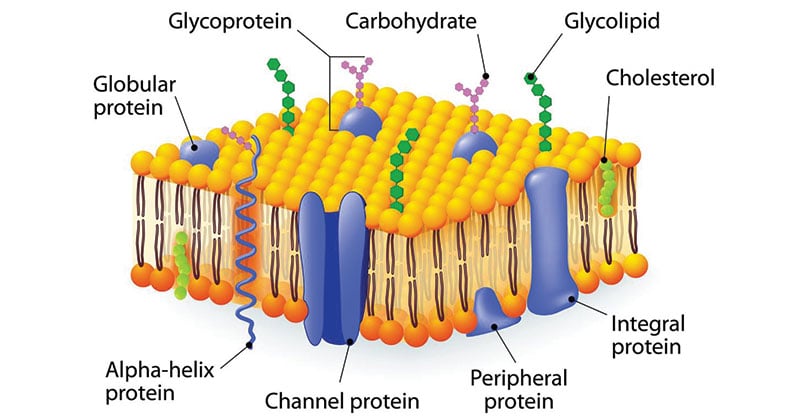- Cell membranes are selective barriers that separate individual cells and cellular compartments.
- Membranes are assemblies of carbohydrates, proteins, and lipids held together by binding forces.
- Carbohydrates are covalently linked to proteins (glycoproteins) or lipids (glycolipids) and also an important part of cell membranes, and function as adhesion and address loci for cells.
- The Fluid Mosaic Model describes membranes as a fluid lipid bilayer with floating proteins and carbohydrates.
- Membrane carbohydrates are chemically bound to glycolipids and glycoproteins.
- However, some membrane carbohydrates are part of proteoglycans that insert their amino acid chain among the lipid fatty acids.
- Although some carbohydrates can be found associated with intracellular membranes, most of them are located in the outer monolayer of the plasma membrane, facing the extracellular space.
Interesting Science Videos
Membrane Carbohydrate Types
Carbohydrate groups are present only on the outer surface of the plasma membrane and are attached to proteins, forming glycoproteins, or lipids, forming glycolipids.
Glycoproteins
- Most of the membrane carbohydrates are found linked to proteins, known as glycoproteins.
- Nearly all the membrane proteins have carbohydrates.
- In the glycoproteins, the majority of the molecule consist of proteins; they have one or more oligosaccharides attached to a protein, and they usually are branched and do not have serial repeats, so they are rich in information, forming highly specific sites for recognition and high-affinity binding by other proteins.
- As in glycolipids, the sugar residues are added in the lumen of the ER and Golgi apparatus. For this reason, the oligosaccharide chains are always present on the non-cytosolic side of the membrane.
- The sugars can be attached to a protein in two locations in the cell, the endoplasmic reticulum, which produces N-linked sugars, and the Golgi apparatus, which produces O-linked sugars. The N-linked glycoproteins have a sugar attached to a nitrogen atom, and O-linked glycoproteins have a sugar attached to an oxygen atom. The different structure of N- and O-linked sugars give them different functions.
- Membrane-bound glycoproteins participate in a wide range of cellular phenomena, including cell recognition, cell surface antigenicity, etc.
Glycolipids
- Glycolipids are membrane lipids in which the hydrophilic head groups are oligosaccharides.
- Three types of glycolipids are found in membranes: glycosphingolipids, which are the most abundant in the animal cells, glycoglycerolipids, and glycophosphatidylinositol. Glycoglycerolipids are more frequent in the plasma membrane of plant cells.
- Only 5 % of lipids in membranes are glycolipids.
- As in glycoproteins, glycolipids act as specific sites for recognition by carbohydrate-binding proteins.
Proteoglycans
- Polysaccharide chains of an integral membrane are called as proteoglycan molecules.
- Proteoglycans, which consist of long polysaccharide chains linked covalently to a protein core, are found mainly outside the cell as part of the extracellular matrix.
- But for some proteoglycans, the protein core either extends across the lipid bilayer or is attached to the bilayer by a glycosylphosphotidylinositol (GPI) anchor.
Membrane Carbohydrate Structure

- Carbohydrates present in the plasma membrane as short sometimes branched chains of sugars attached either to exterior peripheral proteins (forming glycoproteins) or to the polar ends of phospholipid molecules in the outer lipid layer (forming glycolipids).
- Carbohydrate chains may consist of 2-60 monosaccharide units and can be either straight or branched.
- The oligosaccharide chains of membrane glycoproteins and glycolipids are formed by various combinations of six principal sugars D-galactose, D-mannose, L-fucose, N-acetylneuraminic acid (also called sialic acid), N-acetyl-D-glucosamine, and N-acetyl-D- galactosamine. All of these may be derived from glucose.
- The oligosaccharide side chains of glycoproteins and glycolipids are enormously diverse in their arrangement of sugars.
- Although they usually contain fewer than 15 sugars, they are often branched, and the sugars can be bonded together by a variety of covalent linkages—unlike the amino acids in a polypeptide chain, which are all linked by identical peptide bonds.
- Even three sugars can be put together to form hundreds of different trisaccharides.
- In principle, both the diversity and the exposed position of the oligosaccharides on the cell surface make them especially well-suited to a function in specific cell-recognition processes.
Functions of Membrane Carbohydrates
- Membrane carbohydrates perform two main functions: participate in cell recognition and adhesion, either cell-cell signaling or cell-pathogen interactions, and they have a structural role as a physical barrier.
- Blood groups are determined by cell surface carbohydrates of erythrocytes, and they also have the ability to trigger immunological responses.
- After an infection, endothelial cells near the injured tissue expose a type of proteins, known as selectins, in their plasma membranes. They recognize and bind carbohydrates of the plasma membrane of lymphocytes that go through the bloodstream. In this way, lymphocytes get attached to the blood vessel walls, can cross the endothelium and move to the infection focus.
- Carbohydrates as recognition molecules are also important during embryonic development.
- Carbohydrates of the plasma membrane are major recognition and attaching sites for pathogens during infection.
- The glycocalyx also has important functions in humans. It allows cells on the inside of blood vessels to withstand the strong flow of liquid across their surfaces.
- It protects microvilli in the gut, which absorb nutrients, and the glycocalyx even aids in the breakdown of food for this absorption by holding digestive enzymes in its coat.
- Certain plasma transport proteins, hormones, and enzymes are glycoproteins, and in these molecules, carbohydrate is important to physiological activity.
References
- Alberts, B., Johnson, A., Lewis, J., Raff, M., Roberts, K., & Walter, P. (2002). Molecular biology of the cell. New York: Garland Science.
- http://www.biology.arizona.edu/cell_bio/problem_sets/membranes/overview.html
- https://mmegias.webs.uvigo.es/02-english/5-celulas/3-glucidos.php
- https://study.com/academy/lesson/importance-of-carbohydrates-in-the-cell-membrane.html
- https://www.khanacademy.org/science/high-school-biology/hs-cells/hs-the-cell-membrane/a/structure-of-the-plasma-membrane
- http://www.biologydiscussion.com/cell-biology/possible-functions-of-membrane-carbohydrate-with-diagram/3754
- https://www.slideshare.net/girish_bms/membrane-carbohydrate-and-their-significance-in-cellular-recognition
- https://www.ncbi.nlm.nih.gov/books/NBK26878/
- https://www.ncbi.nlm.nih.gov/pubmed/29137479
- https://www.ncbi.nlm.nih.gov/pmc/articles/PMC2109095/
- https://study.com/academy/lesson/what-are-glycoproteins-definition-functions-examples.html
- https://biochemistryquestions.wordpress.com/2009/12/14/glycoconjugates-and-membrane-carbohydrates/

Thanks it is use ful information i appreciate you!
Hi, I just wanted to say you have a really good website thankyou!
Yes, I think your totally right it is so good for the kids education and good for teachers to use.